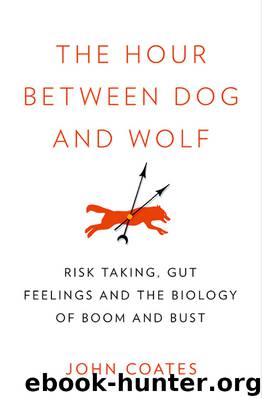The Hour Between Dog and Wolf: Risk Taking, Gut Feelings and the Biology of Boom and Bust by John Coates

Author:John Coates [Coates, John]
Language: eng
Format: epub
ISBN: 9781594203381
Publisher: Penguin Press HC, The
Published: 2012-06-14T00:00:00+00:00
THE WINNER EFFECT
The euphoria, overconfidence and heightened appetite for risk that grip traders during a bull market may result from a phenomenon known in biology as ‘the winner effect’. I first heard of this model during the dot.com years, while listening to a lecture at Rockefeller, and I thought, as I have explained previously, it was the most compelling model of irrational exuberance I had encountered. It was this model that led me back to research, to see if the winner effect exists in the markets.
How does the winner effect work among animals? Does it exist in humans? Can it explain the heightened risk-taking and manic behaviour I had witnessed on Wall Street during the dot.com bubble?
Biologists studying animals in the field had noticed that an animal winning a fight or a competition for turf was more likely to win its next fight. This phenomenon had been observed in a large number of species. Such a finding raised the possibility that the mere act of winning contributes to further wins. But before biologists could draw such a conclusion they had to consider a number of alternative explanations. For example, maybe an animal keeps winning simply because it is physically larger than its rivals. To rule out possibilities such as this, biologists constructed controlled experiments in which they pitted animals that were equally matched in size, or rather that were equally matched in what is called ‘resource holding potential’, in other words the total physical resources – muscular, metabolic, cardiovascular – an animal can draw on in an all-out fight. They also controlled for motivation, because a small, hungry animal eating a carcass can successfully chase off a larger, well-fed animal. Yet even when animals were evenly matched for size (or resources) and motivation, a pure winner effect nonetheless emerged.
Research on the winner effect began with this statistical finding, but it lacked an explanation. How can winning contribute to further wins? Some scientists argued that a victory imparts information to an animal about its own resources and abilities relative to those of rival animals, and this knowledge permits it to choose fights it can win. Others thought that winning may leave physical traces, such as pheromones and other chemicals, on an animal which broadcast its recent victory, and these can deter subsequent opponents from escalating an encounter. But perhaps the most persuasive account is one that highlights the role of testosterone in these competitions.
When two male animals face off they experience a pronounced rise in their testosterone levels. Testosterone’s allotted role in male bodies is to prepare them for precisely these sorts of confrontations. Hence the anabolic effects on muscle mass and haemoglobin. Testosterone has also been found to quicken reactions, to sharpen a type of visual skill known as visuo-motor scanning, and to enhance another visual ability known as camouflage breaking. Just as important as the physical preparation is the hormone’s tendency to increase an animal’s persistence and fearlessness. After all, there would be little point in equipping an animal with a greatly augmented fighting capacity if it were not willing to use it.
Download
This site does not store any files on its server. We only index and link to content provided by other sites. Please contact the content providers to delete copyright contents if any and email us, we'll remove relevant links or contents immediately.
Hit Refresh by Satya Nadella(8854)
The Compound Effect by Darren Hardy(8508)
Change Your Questions, Change Your Life by Marilee Adams(7371)
Nudge - Improving Decisions about Health, Wealth, and Happiness by Thaler Sunstein(7242)
The Black Swan by Nassim Nicholas Taleb(6762)
Deep Work by Cal Newport(6563)
Daring Greatly by Brene Brown(6222)
Rich Dad Poor Dad by Robert T. Kiyosaki(6174)
Principles: Life and Work by Ray Dalio(5957)
Man-made Catastrophes and Risk Information Concealment by Dmitry Chernov & Didier Sornette(5646)
Playing to Win_ How Strategy Really Works by A.G. Lafley & Roger L. Martin(5493)
Digital Minimalism by Cal Newport;(5389)
Big Magic: Creative Living Beyond Fear by Elizabeth Gilbert(5351)
The Myth of the Strong Leader by Archie Brown(5237)
The Slight Edge by Jeff Olson(5199)
Discipline Equals Freedom by Jocko Willink(5156)
The Motivation Myth by Jeff Haden(5001)
Stone's Rules by Roger Stone(4854)
The Laws of Human Nature by Robert Greene(4770)
